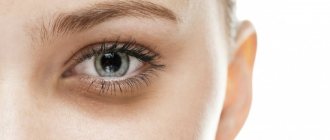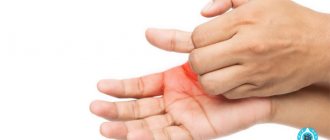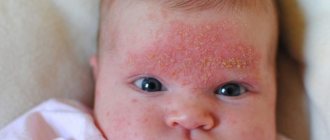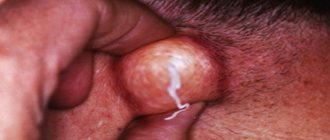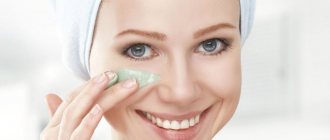Why do acne appear on the neck? The article describes the causes, symptoms and treatment methods.
For any person, appearance always plays a primary role, and for women it is much more important than for men. And rashes on open areas of the body, in addition to physical discomfort, often also cause emotional distress.
Read another article on our website on the topic: . ” You will find a list, names, instructions for use. You will also learn about a homemade, folk remedy for youthful acne on the face, which will quickly help, the best proven recipes.
The neck is one of the most “favorite” places for pimples, after the face. Such formations can ruin not only the appearance, but also the mood for a long time. This article describes the causes of this rash, symptoms and treatments. Read on.
Symptoms of acne on the neck
Acne on the neck
Acne usually refers to inflammatory diseases of the hair follicle or sebaceous gland, which is located in the middle layer of the skin - the dermis. The sebaceous gland is hormone-dependent, its function is to produce sebum; the pituitary gland, hypothalamus, gonads and adrenal glands are involved in this process.
Acne usually occurs in the area of the skin with the maximum number of sebaceous glands, while in a person prone to formations, visually oily hair, spots or scars on the skin, and a greasy sheen. In some forms of rashes, the harbinger, on the contrary, is excessive dryness of the skin and flaking.
The classification of acne is varied, but there are only three forms:
- Comedonal - non-inflammatory formation with sebaceous contents
- Papulopustular - inflamed formation
- Nodal - conglobate
The latter form is severe, with pimples reaching large sizes, noticeably rising above the skin. Treatment of this form lasts up to 3-4 months, with the obligatory presence of scars after treatment.
Symptoms of acne on the neck are very different:
- This can include teenage acne, late adult acne, and rosacea with a vascular pattern (rosacea).
- The most important thing in symptoms is to divide the rashes into inflammatory and non-inflammatory acne.
Why does a pimple go into the inflammatory stage, sometimes even becoming like a boil? In most cases this happens when:
- Touching your face with dirty hands
- Trying to get rid of a pimple unprofessionally
- Attempts to squeeze out the contents of the inflamed tubercle, which always leads to secondary infection
An inflamed formation must not be left without attention and proper treatment, especially when rashes appear profusely and pain increases. It is necessary to contact a specialist as soon as possible and begin competently selected treatment.
White pimples on the neck: causes
White pimples on the neck
White pimples are, in a simple sense, a kind of “cyst” of small size - 1-1.5 mm. in diameter. Tactilely, such a pimple feels like a dense nodule under the skin with clear boundaries, yellowish or almost white in color. This type of pimple is also called millet or milium, and it is very important not to confuse it with a closed comedon. Comedones and milia form in various layers of the epidermis, and if the former appear due to blockage of the hair follicle or sebaceous gland, then cysts form without affecting the sebaceous ducts and hair follicles.
There are many reasons for the appearance of white pimples on the neck:
- Poor nutrition with a predominance of fatty, smoked foods, and as a result – disruption of the sebaceous gland.
- Rubbing the skin or other injury.
- Use of low quality decorative cosmetics.
- Various skin diseases: seborrhea, cutaneous porphyria, lupus and others.
- Taking hormonal medications or hormonal imbalance for other reasons, often the cause is the predominance of male hormones in women.
- Disturbances in the functioning of the digestive tract, especially affecting the functioning of the gallbladder.
Milia can be diagnosed at any age, in both men and women, and are more often activated in adolescence at the time of hormonal changes. There are known cases of the presence of such formations even in newborns, but when the excessive activity of the sebaceous glands decreases, they disappear without a trace.
Also, “cysts” can form suddenly at first glance, but such an appearance is almost always due to the favorable, special condition of the skin and a genetic factor.
Subcutaneous, large, painful pimples under the neck, on the back: causes
Subcutaneous pimples differ from regular rashes not only in appearance and pain, but also in the fact that getting rid of them is not so easy. A subcutaneous pimple forms in the deep layers under the dermis and is characterized by prolonged maturation, pain, and swelling. Many people try to get rid of them on their own; attempts to squeeze them out on their own are especially dangerous: such manipulations always leave scars at the site of the pimple, or even fistulas form. Why do subcutaneous, large, painful pimples appear under the neck and on the back?
The reasons for the formation of subcutaneous formations are varied and similar to other types of acne, but there is one distinctive feature - subcutaneous mite (Demodex) . Therefore, it is so important to consult a specialist in time to exclude demodicosis.
In addition to this pathology, possible causes are:
- Pregnancy
- Menopause
- Adrenal and other endocrine disorders
- Eating disorder
- Dermatovenerological diseases
- Frequent and aggressive peeling
At the first stage, the formation of a pimple is invisible, slight discomfort and redness are possible.
At the second stage, a noticeable compaction appears, the size of which grows over several days and becomes visually noticeable.
At the third stage, the pimple is ripe. This is already an impressive, painful tubercle with a white or black top.
Symptoms
Common acne that appears on any part of the body can be described as hard lumps that rise above the surface of the epidermis or are buried in its thickness. They may be inflamed - with redness, cyanosis, with white or other colored rods, as well as with liquid hemorrhagic or purulent contents.
In addition, acne can be:
- painful;
- aching;
- itchy;
- bleeding;
- cause a local and general increase in body temperature.
Psychosomatics - acne on the neck: why do they appear?
Acne on the neck
Mental state and the appearance of acne are directly related. Rashes often signal problems with a person’s emotional state, and not just the impact of external and internal factors. Against the background of persistent neurosis, excoriated acne often develops, which the patient begins to squeeze out and injure, provoking further inflammation.
If, after diagnosis and consultation with specialists, the causes of acne on the neck are not found, we can talk about psychosomatics. Why do they appear? Here are some reasons:
- If a person does not accept himself as an individual, has low self-esteem, and cannot come to terms with his character, then the rash becomes permanent and difficult to treat.
- This all happens unconsciously: a person tries to isolate himself, not to contact the outside world, and excessive rashes and inflammations are in such a situation a kind of defensive reaction, a way to “hide in the house.”
- When the number of acne increases sharply for no apparent reason, in practice this is preceded by a stressful situation.
If the reason lies in psychosomatics, then a psychotherapist must be involved in the treatment, who conducts cognitive therapy, hypnosis treatment, and understands the root of internal problems.
Diagnostics
To diagnose acne on the neck, it is necessary to undergo a number of general tests - blood, urine and biochemistry, and undergo mandatory specialized examinations.
It is important to identify the main pathogen in case of local skin lesions. To do this, scraping is done from the skin (for fungus and psoriasis) or the contents from the element are inoculated. If pathological bacterial flora is detected, an antibiotic sensitivity test is performed.
If the allergic nature of the disease is suspected, blood is donated to determine immunoglobulin E, as well as a skin test to identify the pathogenic allergen.
It is also recommended to check your blood for hormones and get tested for HIV and syphilis.
Lupus is diagnosed by a number of clinical and laboratory symptoms. In the blood, the appearance of special LE cells is characteristic - leukocytes containing in the split nuclei of other cells.
There are a lot of pimples on the neck: how to treat it, how to get rid of it if the pimples still itch?
When swelling and redness appear with heavy rashes, this always indicates that active work is underway with bacteria and an immune reaction is activated. Bacteria begin to actively multiply in the clogged pore, the body tries to deliver leukocytes to the damaged areas in the shortest possible time and in large quantities, and reduce the activity of bacteria. It is at this stage that itching and discomfort begins in the form of a slight tingling sensation. So, there are a lot of pimples on the neck - how to treat it, how to get rid of it if the pimples also itch?
As already mentioned, it is imperative to exclude demodicosis, against which the itching is more severe. You also need to know that itching and redness are not necessarily acne, but possibly a sign of an allergic reaction or skin disease such as eczema and dermatitis. For such pathologies, treatment should be started only as prescribed by a doctor.
The correct behavior when itching is to never scratch or injure the already inflamed skin. If such problems regularly arise, it is advisable to:
- Take vitamin complexes with zinc and copper.
- Take vitamins A and E in capsules, especially with selenium. They accelerate the regeneration of injured skin.
- After consulting a specialist, carry out local antibacterial therapy. These are usually alcohol-based solutions that facilitate deep penetration of the active ingredients. Antibiotics may also be prescribed in the form of an ointment.
It is also possible to prescribe hormonal drugs, but only by a specialist. Self-medication is dangerous for skin health.
Treatment and prevention
You should not start treating acne on your neck. Banal folliculitis after shaving can lead to the development of serious purulent complications. Up to the formation of sycosis, abscesses and carbuncles.
Purulent skin diseases (with the exception of folliculitis) are treated surgically. It is imperative to remove the accumulation of pus and clean the cavity. Antibiotics are prescribed in the form of applications and ointments, which are injected directly into the cavity.
Symptomatic treatment is used to treat viral infections. For measles, therapy includes expectorants, drugs to reduce fever, and washing the eyes with strong tea. Antihistamines are used to relieve itching. It is recommended to use antihistamines throughout the entire period of illness.
Treatment of rubella is similar to the treatment of measles infection.
Important: do not take aspirin during measles. It can lead to the development of Reye's symptom - an acute condition with cerebral edema and fatty liver.
Chickenpox rashes are treated with any aniline dye or antiseptic - brilliant green, fucarcin, chlorhexedine, etc. This is necessary to prevent the addition of a secondary infection. For severe itching, antihistamines are prescribed.
Treatment of pityriasis versicolor includes the use of systemic and local antimycotic agents - clotrimazole, fluconazole. Shampoos with antifungal agents can also be used to wash.
With a good immune system, molluscum contagiosum goes away on its own after a few months. For extensive rashes, surgical treatment is possible - removal of the contents of the papules followed by cauterization with iodine. It is recommended to treat with camphor alcohol daily. Liquid nitrogen freezing and laser ablation can also be used. After the papule is punctured, there are no traces or scars left at the healing site.
Systemic lupus should be treated under strict supervision in a hospital setting. Glucocorticosteroids, immunosuppressants and detoxification (blood purification by plasmapheresis or hemosorption) are used.
Prevention
- Careful body hygiene.
- Selection of hypoallergenic products for washing and personal hygiene.
- Do not share towels under any circumstances. Clothes and bed linen.
- Timely treatment of pustules to avoid complications.
- Carrying out vaccinations according to the calendar.
- Regular blood donation for HIV and syphilis.
- Use of protective barrier contraceptives during casual sex.
- Strengthening the immune system.
- Proper nutrition.
- Treatment of gastrointestinal diseases.
[carousel-horizontal-posts-content-slider]
Pimple on the neck: a sign
Pimple on the neck
Usually, rashes appear for very obvious reasons, but especially superstitious people and those who obsessively maintain the hygiene of their body always look for a hidden meaning in pimples. Here is a description of the existing signs of acne on the neck:
- A rash in the back of the head means “hello” from the past.
- Distant relatives with whom you are at odds may suddenly appear on the horizon, your former boss will call you back to work, or your ex-husband wants to renew the relationship.
- If a pimple appears on the left side of the neck, and cannot be treated, and is painful when pressed, then according to signs this means a certain “burden” on the person. He needs to go to church, repent, and perhaps ask forgiveness from his loved ones.
- But the right side of the neck, according to signs, is considered the side under the supervision of the Guardian Angel. If inflammation appears in this particular area, then this is a kind of warning. Perhaps the person is doing the wrong things, choosing the wrong people as friends. This is a kind of signal to stop and think.
To sum up this interesting and difficult topic, we can conclude that acne on the neck can be dealt with quite successfully. The most effective method is prevention, no self-medication or folk methods, but of course, in severe cases, immediate contact with specialists. Good luck!


